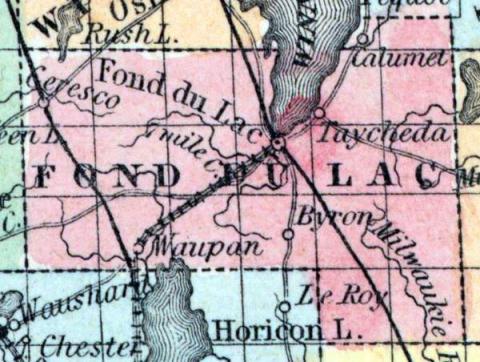FOND DU LAC, a flourishing town, capital of Fond du Lac county, Wisconsin, is admirably situated at the S. end of Winnebago lake, 72 miles N. N. W. from Milwaukee, and 00 miles N. E. from Madison, Lake Winnebago, which is a beautiful sheet of water, 30 miles long and 10 miles wide, forms a link in the chain of navigable waters, connecting Lake Michigan and its tributaries with the Mississippi river, and is the channel of an active and extensive trade. The Fox river, by which Winnebago lake communicates with Green bay, is to be rendered navigable for steamboats, and a canal has been cut from the some river to the Wisconsin. Fond du Lac has grown up almost entirely since 1845, and the population has increased with surprising rapidity. A plank-road has been constructed from this place to Sheboygan, on Lake Michigan, and similar roads are projected in several other directions. The Fond du Lao and Rock River railroad, nearly finished, will connect Fond du Lac with Chicago. The town is built on ground ascending gradually from the lake, and is pleasantly embowered among groves and clumps of trees. It has an abundance of the purest water, obtained by means of artesian wells, which vary in depth from 90 to 130 feet. These wells are very numerous, almost every family being provided with one. It contains 3 newspaper offices, 2 banking houses, 1 car factory, 1 iron foundry, 12 dry goods stores, and about 60 other stores. Population in 1850, 2014; in 1853, about 4000. (Baldwin's New and Complete Gazetteer of the United States..., 1854)
FOND DU LAC, City. This place was one of the earliest located towns in Wisconsin, a paper city, laid out and platted several years in advance of the progress of civilization. But the past ten years has wrought a change which few Western towns can rival. The city is located at the head of Lake Winnebago, on section 10, town 15, of range 17 E. The principal business portion is situated about three-quarters of a mile from the lake, on the Fond du Lac river, whose mouth forms a convenient port of entry for the steam boats and other water crafts which run between this place, Oshkosh, Wolf river, and Upper and Lower Fox rivers. The river, at the upper part of the city and a short distance above, furnishes several very fair mill powers for the manufacture of lumber, flour, &c, and on which an oil mill is also being erected. The principal part of the city is built upon a level prairie on the east side of the river. On the west side was formerly a beautiful sugar maple grove, which affords one of the most inviting and pleasant retreats that could well be desired, and in which are erected a large number of private residences, which are destined to be the most desirable in the city. The place is backed up and sustained by one of the richest and most productive farming counties in the State. One of the most inviting features of this place, is the pure water with which it is supplied, from the large number of never-failing fountains, or artesian wells, which brings the water to the surface of the earth, and yields a most bountiful supply of as pure water as can be found in the State, and to which may be attributed, in a great degree, the extensive healthfulness of the place. The streets are wide, the lots of convenient size, and laid out with much uniformity and taste— with several public squares, which, when properly improved, will add much to the beauty of the place. About 3 miles of double plank road has been constructed within the limits of of the city. A large amount of money has also been expended in building side-walks throughout the entire city, which are mostly of plank, and of very convenient width. The present population of the city is estimated at about 4,000, and is rapidly increasing by the influx of business men and capitalists from the East. It was first incorporated as a village in 1847, and a city charter granted in the winter of 1852. There are in the city 9 hotels, 2 exchange or banking houses, 12 dry goods, 15 grocery and provision, 4 clothing, 4 wine and liquor, 8 boot and shoe, 2 hat and cap, 4 harness and leather, 3 stove and tin ware, and 1 iron and hardware stores; 2 jeweller, 5 cabinet, 5 blacksmith, 3 paint, 2 gun, 3 waggon, and 3 milliner shops; 4 warehouses, 4 lumber yards, 5 saloons, 3 livery stables, 6 bakeries, 1 foundry, 3 sash and blind factories, 4 meat markets; 1 cigar, 1 car, and 1 cradle manufactory; 1 book bindery, 2 planing mills, 3 nursery establishments, 1 auction store, 2 daguerrean galleries, 3 printing offices, 16 law offices, 9 physicians and surgeons, 3 barber's shops. In addition to these, there are a large number of small establishments, where various kinds of business are carried on with great success. There are 7 religious denominations. (John Warren Hunt, Wisconsin Gazetteer..., Madison, 1853)

